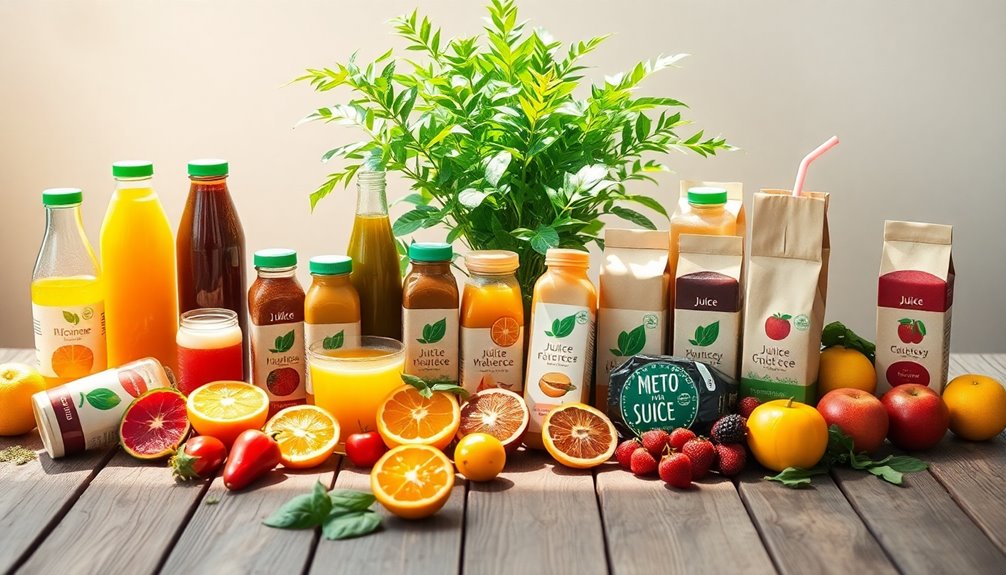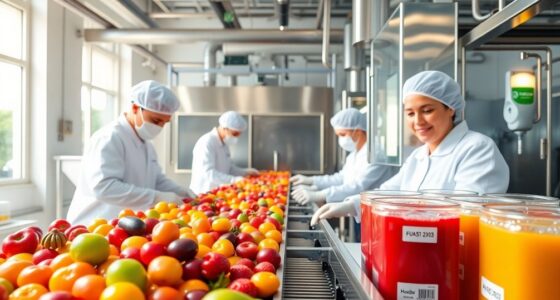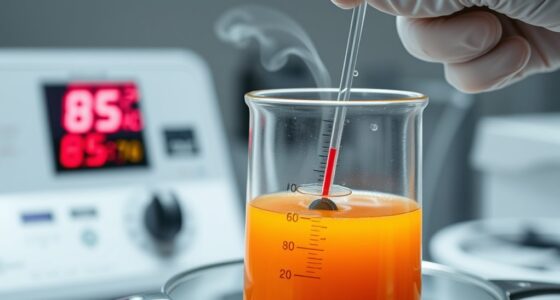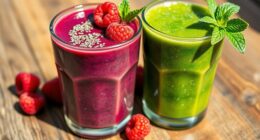Sustainable sips are changing the juice packaging game! You’ll find innovative solutions like eco-friendly, bio-based materials, and reusable containers that cut down on plastic waste. Aseptic technology extends shelf life while using renewable energy reduces carbon emissions. Plus, compostable packaging options guarantee zero waste. Engaging designs and smart tech keep you informed about freshness and sustainability. These exciting developments pave the way toward a greener future, and there’s even more to explore beyond these key points! As consumers become more conscious of their environmental impact, brands are embracing green packaging for natural drinks to appeal to eco-friendly preferences. This shift not only enhances brand loyalty but also promotes a circular economy by recycling materials and reducing resource consumption. With advancements in technology and design, the landscape of beverage packaging continues to evolve, ensuring that sustainability remains at the forefront of every sip.
Key Takeaways
- Eco-friendly packaging materials like compostable films and bio-based options significantly reduce plastic waste and enhance sustainability in juice packaging.
- Reusable juice containers made from stainless steel or glass lower single-use plastic waste and keep juice fresh longer.
- Aseptic technology extends juice shelf life while minimizing energy consumption and maintaining natural flavors without preservatives.
- Smart packaging innovations provide real-time freshness updates and promote responsible recycling, enhancing consumer engagement and sustainability efforts.
- Community engagement through local sourcing and educational campaigns fosters a culture of sustainability and supports local economies.
The Rise of Eco-Friendly Packaging Solutions
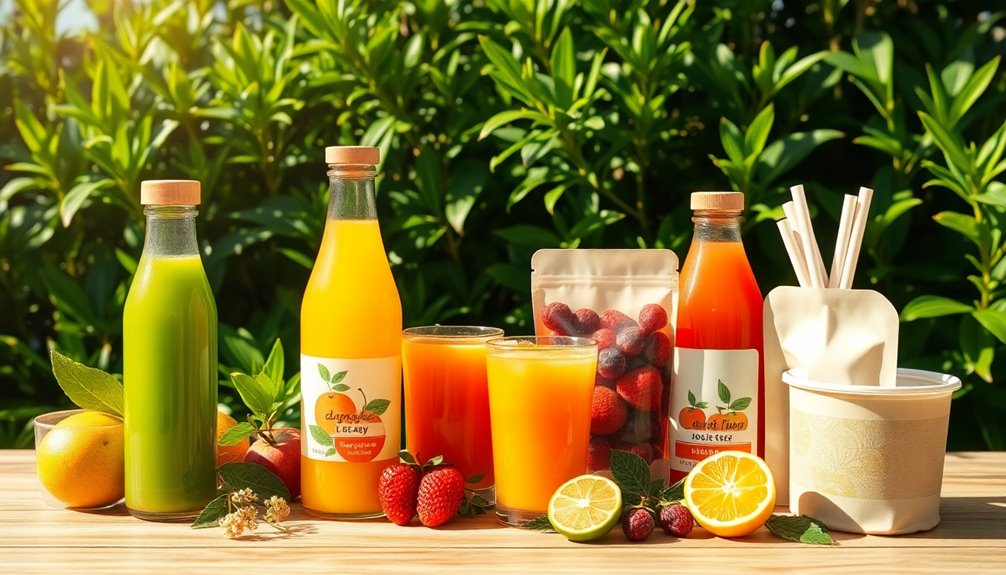
As consumers prioritize environmental responsibility, the demand for eco-friendly packaging solutions has surged, prompting brands to rethink their packaging strategies.
You'll notice that many companies are now focusing on sustainable packaging, which not only addresses consumer concerns but also reduces their environmental footprint.
Flexible packaging, while often critiqued, typically uses less material than rigid options, lowering energy consumption during production and transport.
Innovative recyclable films, like Frito Lay's potato chip bags, encourage responsible disposal and enhance recyclability.
Major brands are also introducing bio-based and compostable packaging, made from renewable resources such as corn starch and sugarcane.
These initiatives aim to create thinner, stronger materials, minimizing raw material use and supporting sustainability efforts across the industry. Additionally, adopting merchant account credit processing can further enhance brand credibility by ensuring secure transactions, aligning with sustainability goals.
Innovations in Biodegradable Materials
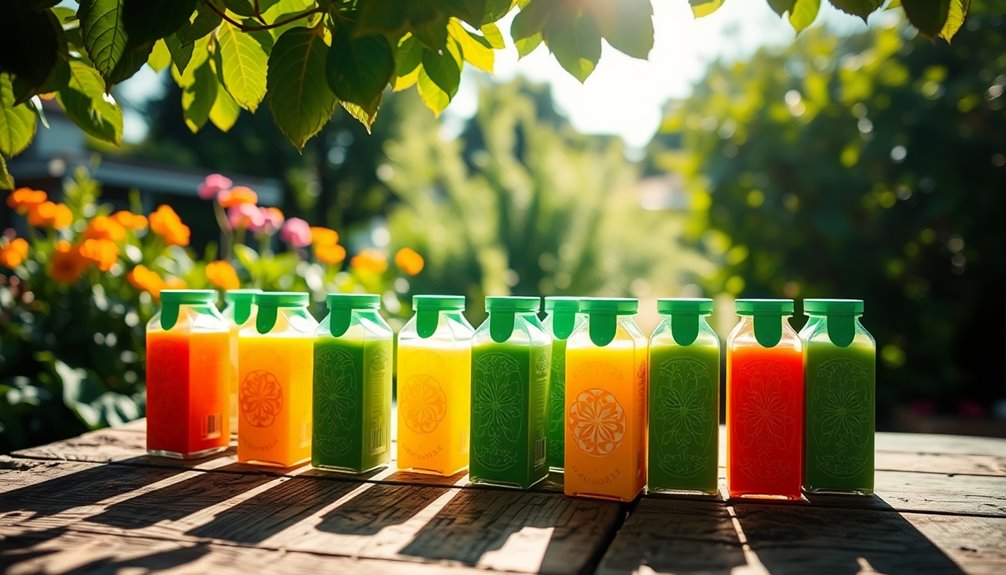
With the push for sustainability gaining momentum, innovations in biodegradable materials are revolutionizing juice packaging.
You'll find that materials derived from sugarcane pulp fibers and corn starch offer sustainable alternatives that effectively reduce plastic waste in landfills.
Companies like Frito Lay are developing biodegradable films that maintain product integrity while being eco-friendly and recyclable.
Compostable packaging decomposes in industrial composting facilities, contributing to a circular economy.
Recent advancements in bio-based plastics allow for faster decomposition than traditional materials, with options even breaking down in home compost bins.
The introduction of fully recyclable pouches by brands like Capri-Sun underscores the industry's commitment to sustainability, achieving a lower carbon footprint while ensuring quality in juice packaging. Additionally, the use of biodegradable materials can significantly reduce the environmental impact of packaging waste, promoting a healthier planet for future generations.
Benefits of Reusable Juice Containers

Using reusable juice containers can considerably reduce your impact on the environment by cutting down on single-use plastic waste.
Not only do they help protect our oceans and landfills, but they also offer a cost-effective way to store your juice by allowing you to buy in bulk.
Plus, many of these containers keep your juice fresh longer, minimizing waste and ensuring you get the most out of your purchase. Additionally, using natural antibacterial properties from essential oils can further enhance the cleanliness of your reusable containers.
Environmental Impact Reduction
Switching to reusable juice containers can greatly reduce your impact on the environment. By ditching single-use plastics, you help cut down on pollution and decrease your carbon footprint associated with juice packaging.
These sustainable solutions often use eco-friendly materials like stainless steel or glass, which are far better for the planet than traditional plastics. When you choose reusable containers, you also contribute to lower demand for new packaging production, leading to reduced energy consumption and resource extraction.
Studies show that making this switch can decrease greenhouse gas emissions by up to 70%, showcasing how effective reusable containers are in combating climate change. Additionally, using juices rich in vitamins can promote overall health, making your sustainable choice even more beneficial.
Cost-Effective Storage Solutions
When you opt for reusable juice containers, you're not just making an eco-friendly choice; you're also investing in a cost-effective storage solution.
By reducing waste from single-use packaging, you contribute to a sustainable environment while saving money over time. High-quality, durable containers eliminate the need for constant purchases of disposable options.
Plus, many of these containers are designed to be leak-proof and easy to clean, ensuring convenience and hygiene. Switching to reusable juice containers encourages bulk buying, which often lowers your per-unit costs.
Additionally, their airtight seals help maintain the freshness and flavor of your juices longer, enhancing your overall experience. Furthermore, using energy-efficient operation for your juice storage solutions can help minimize your environmental impact and save on electricity costs.
Make the switch today for both your wallet and the planet!
Energy-Efficient Production Methods
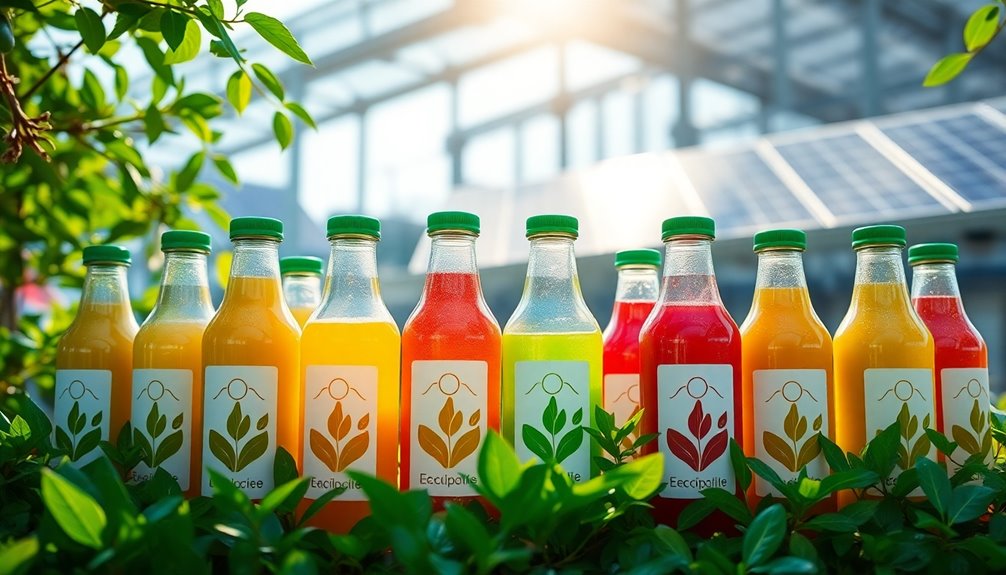
When you consider energy-efficient production methods, think about how renewable energy utilization can transform the juice packaging process. By incorporating waste reduction techniques, you not only cut costs but also support a greener environment. These strategies play an essential role in creating a sustainable future for juice products, especially when utilizing advanced technology to increase efficiency and reduce energy consumption.
Renewable Energy Utilization
As companies increasingly prioritize sustainability, utilizing renewable energy in juice packaging production stands out as a game-changer.
By embracing renewable energy utilization, you can considerably reduce carbon emissions and enhance your operational efficiency.
Here are three key benefits:
- Carbon footprint reduction: Companies using solar or wind energy can lower greenhouse gas output by up to 70%.
- Energy consumption decrease: Advanced machinery powered by renewable energy can cut energy use by approximately 30% compared to traditional methods.
- Cost savings: Adopting energy-efficient technologies can lead to 15-20% savings on energy bills. Additionally, integrating energy-efficient technology can further promote sustainable operational practices.
Waste Reduction Techniques
While implementing waste reduction techniques in juice packaging, energy-efficient production methods play a crucial role in minimizing environmental impact.
By utilizing advanced technologies, you can markedly reduce energy consumption during manufacturing, which leads to a smaller carbon footprint.
Flash-heating processes not only guarantee safety by killing pathogens but also use less energy compared to traditional methods.
Aseptic packaging eliminates the need for refrigeration during transport and storage, conserving both energy and resources.
Additionally, innovations in lighter and thinner packaging materials require less energy during production and transport, further enhancing waste reduction.
Finally, adopting renewable energy sources in your production facilities can lead to considerable reductions in greenhouse gas emissions, making your juice packaging more sustainable overall. Furthermore, integrating energy-efficient heat pumps in your facilities can significantly enhance overall energy management and reduce operational costs.
Aseptic Technology for Extended Shelf Life
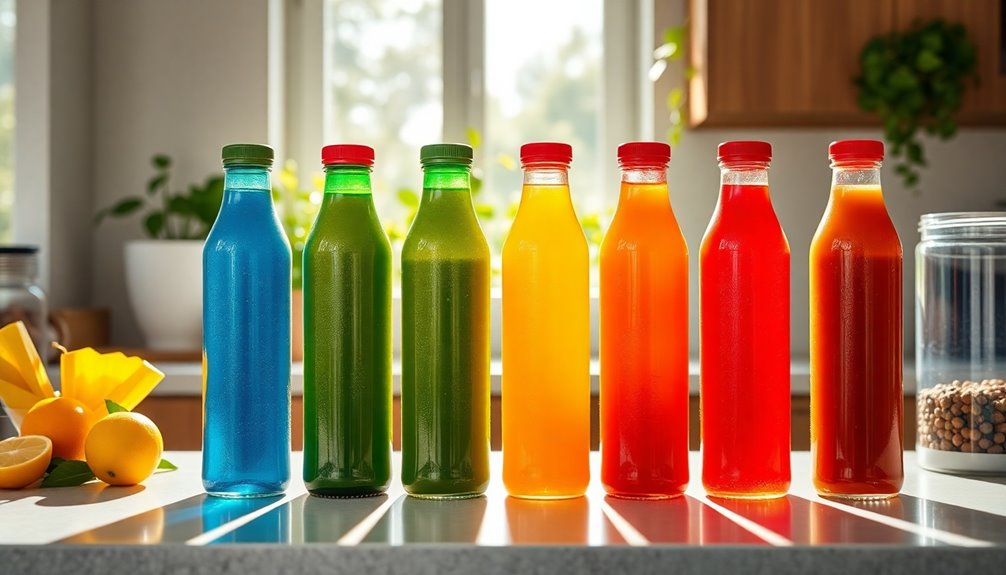
Aseptic technology revolutionizes juice preservation by utilizing a flash-heating process that effectively eliminates pathogens, ensuring safety and extending shelf life without relying on preservatives. This method not only maintains the juice's natural flavor and nutritional qualities but also prevents contamination through sterilized packaging. Here are three key benefits of using aseptic technology for juice packaging:
- Extended Shelf Life: Juices stay fresh longer, reducing waste.
- Energy Efficiency: No refrigeration is needed during storage and transportation, cutting energy consumption and carbon footprint.
- Cost-Effective: Manufacturers enjoy savings on storage and distribution, making it a sustainable choice. Additionally, the use of high-quality packaging materials can further enhance the preservation of juice quality.
Smart Packaging for Enhanced Consumer Interaction
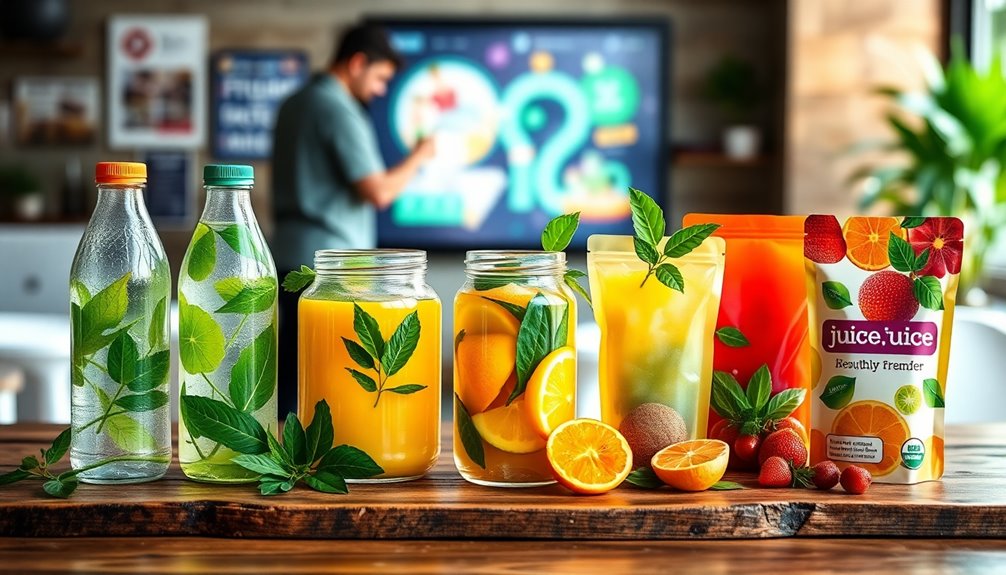
Smart packaging is transforming how you interact with juice products.
With features like augmented reality and sensory engagement elements, your experience goes beyond just drinking juice.
Imagine scanning a package to access personalized content and real-time freshness updates—all designed to make your choices easier and more enjoyable.
Interactive Packaging Features
How can interactive packaging revolutionize your juice experience? With smart packaging features, your juice isn't just a drink; it's an engaging experience.
Imagine knowing exactly when your juice is fresh or getting personalized recommendations based on your tastes. Here are three ways interactive packaging enhances your experience:
- Freshness Monitoring: Sensors track the juice's freshness, sending real-time updates straight to your phone.
- Automatic Reordering: IoT solutions let you reorder your favorite juices when you're running low, ensuring you never run out.
- Eco-Friendly Tips: Interactive packaging provides essential recycling information, promoting sustainability while you enjoy your juice.
Additionally, visual representation of the juice's nutritional benefits through the packaging can further enhance consumer engagement and awareness. These interactive packaging features not only elevate your enjoyment but also contribute positively to the environment.
Augmented Reality Experiences
Ever wondered how augmented reality (AR) can transform your juice packaging experience? With AR technology, you can scan your juice package using your smartphone to access interactive experiences. This not only enhances your engagement but also provides real-time information about freshness and shelf life through smart packaging features.
Imagine diving into immersive storytelling that showcases the brand's sustainability efforts and ingredient sourcing. You'll also find informative content about recycling and disposal methods, helping you commit to environmental responsibility.
Plus, integrating AI with augmented reality means you can receive personalized recommendations based on your preferences, making your shopping experience even better. Embrace AR, and watch how it elevates your connection with your favorite juice brands!
Sensory Engagement Elements
What if your juice packaging could do more than just hold your favorite drink?
With sustainable packaging innovations, it can engage your senses and enhance your experience.
Here's how:
- Freshness Sensors: Embedded sensors monitor your juice's freshness, giving you real-time feedback on quality and expiration.
- Augmented Reality: Scan the packaging with your smartphone to uncover interactive brand stories and product details, making every sip a journey.
- Personalized Recommendations: AI algorithms suggest juices based on your tastes, making it easier to discover new favorites.
Flexible Packaging: Balancing Convenience and Sustainability
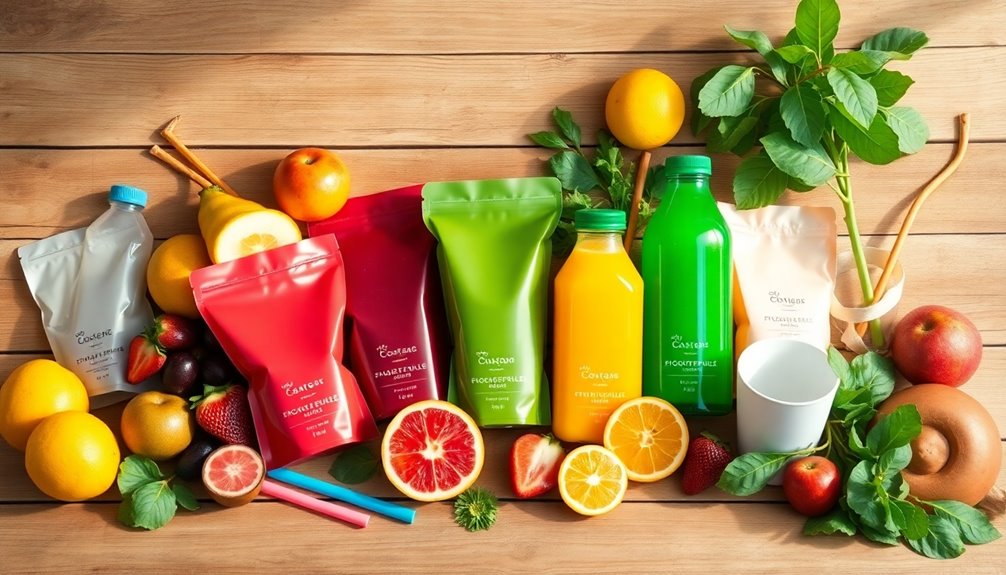
As consumers increasingly seek convenience in their daily lives, flexible packaging emerges as a compelling solution that balances ease of use with sustainability.
This lightweight and compact option optimizes transport efficiency and uses less raw material than rigid packaging, reducing environmental impact.
Innovative recyclable films now make it easier for you to dispose of juice packaging responsibly, aligning with your eco-conscious values.
Plus, flexible packaging technology cuts energy consumption during production and transportation, further minimizing your carbon footprint.
Its pliability allows for eye-catching designs that enhance your experience while keeping products fresh.
Despite past criticisms, advancements in flexible packaging focus on sustainability, with many brands adopting bio-based and compostable materials to meet the growing demand for environmentally friendly options.
Community Engagement Through Local Sourcing
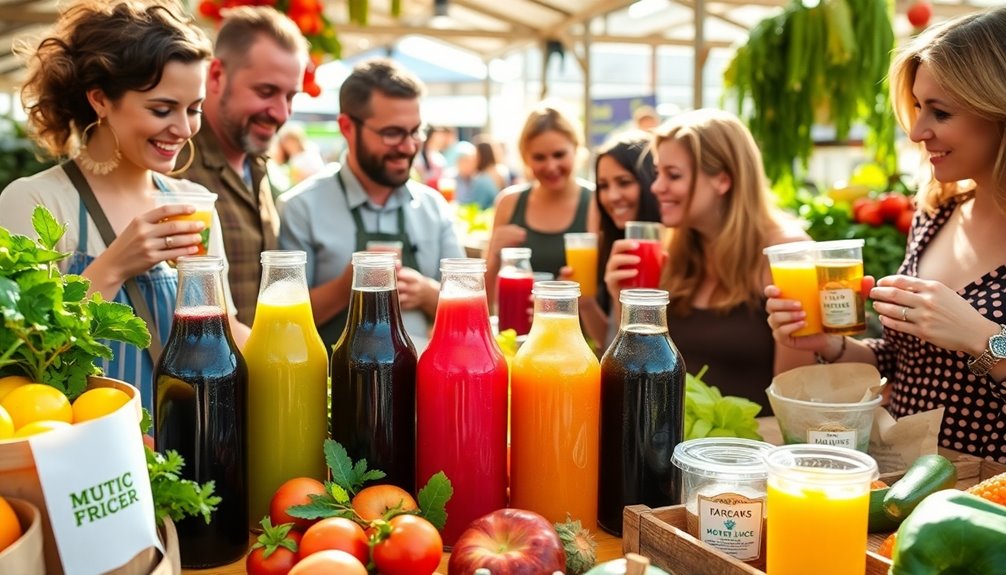
When you choose locally sourced ingredients for your juice, you're not just enjoying fresh flavors; you're also supporting your community.
Local sourcing strengthens ties with farmers and fosters sustainable practices, contributing to regional economies and reducing transportation emissions. Plus, it's a great way to connect with local culture.
Here are a few ways local sourcing engages your community:
- Celebrate Local Traditions: Community-themed packaging can highlight local values and foster pride.
- Collaborate with Artists: Engaging local artists for packaging designs can reflect your community's unique narratives.
- Limited-Edition Flavors: Offering juice products that showcase local ingredients can spark interest and create a shared identity.
Educating Consumers on Responsible Disposal

Understanding how to properly dispose of juice packaging is essential for minimizing environmental impact. Educating consumers on responsible disposal involves informing you about the recyclability of various packaging materials, like the new mono-material (PP) pouches from Capri-Sun, which are fully recycle-ready.
It's vital to check your local recycling guidelines, as these can vary by country, ensuring you dispose of juice packaging correctly. Remember, improperly disposed packaging contributes to pollution, so always follow the disposal instructions on the packaging.
Rinsing out juice pouches before tossing them in recycling bins enhances recycling efforts. Engaging in educational campaigns can help you understand the impact of your choices, fostering a culture of sustainability and responsible waste management.
Compostable Packaging: A Sustainable Alternative

Compostable packaging offers a promising solution for those seeking to reduce their environmental footprint. By choosing compostable options, you're contributing to a more sustainable future.
Here are some key benefits:
- Fast Decomposition: Compostable packaging breaks down quickly in industrial facilities, reducing landfill waste.
- Lower Carbon Footprint: Made from renewable resources like corn starch and sugarcane, these materials generate fewer carbon emissions than traditional plastics.
- Consumer Demand: The shift towards compostable packaging reflects your desire for eco-friendly choices, encouraging brands to innovate.
Companies like PepsiCo are leading the way with compostable structures, proving that sustainable solutions aren't just feasible but necessary.
The Role of Technology in Sustainable Packaging
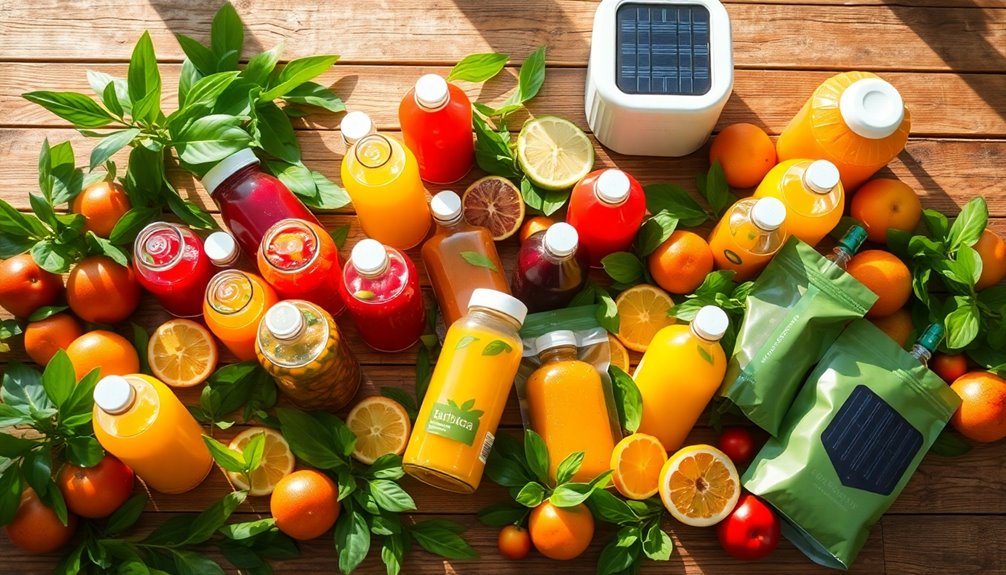
As the demand for sustainable packaging solutions grows, technology plays an essential role in transforming how juice products are packaged and delivered.
Advanced packaging materials utilize aseptic technology, preserving flavor and extending shelf life while eliminating pathogens.
You can benefit from smart packaging innovations featuring embedded sensors, providing personalized juice recommendations through AI and machine learning.
Eco-friendly packaging solutions are also making strides, with recyclable films that lower energy consumption during production.
Notable brands like PepsiCo are introducing biodegradable and compostable packaging made from renewable resources like corn starch and sugarcane.
Plus, IoT integration allows for automatic reordering, enhancing your convenience while promoting sustainable consumption practices.
Embracing these technologies means supporting a greener future for juice packaging.
Consumer Preferences Driving Packaging Innovations
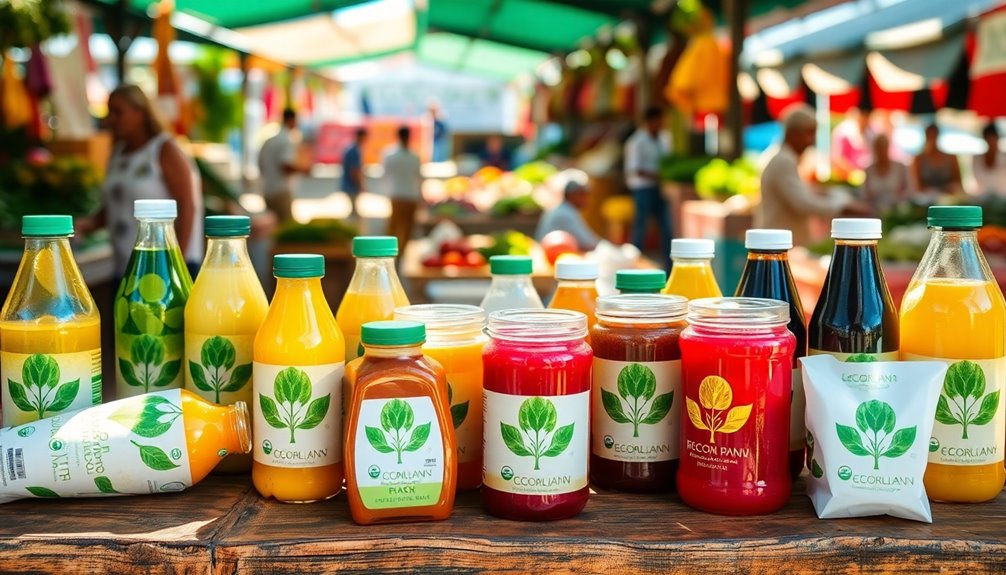
With consumers increasingly prioritizing sustainability, brands are responding by innovating their packaging solutions to align with these values.
This shift is evident in several key trends:
- Eco-Friendly Materials: Brands are using recyclable films and bio-based materials to meet your expectations for sustainable options.
- Flexible Packaging: Lightweight and protective, flexible packaging often uses less material, reducing environmental footprints.
- Compostable Options: Fully recyclable or compostable packaging, like those from Capri-Sun, shows a commitment to minimizing CO2 emissions.
As you become more aware of the ecological impact of packaging waste, brands are compelled to create sustainable packaging solutions that not only protect the product but also resonate with your environmental concerns.
Future Trends in Sustainable Juice Packaging
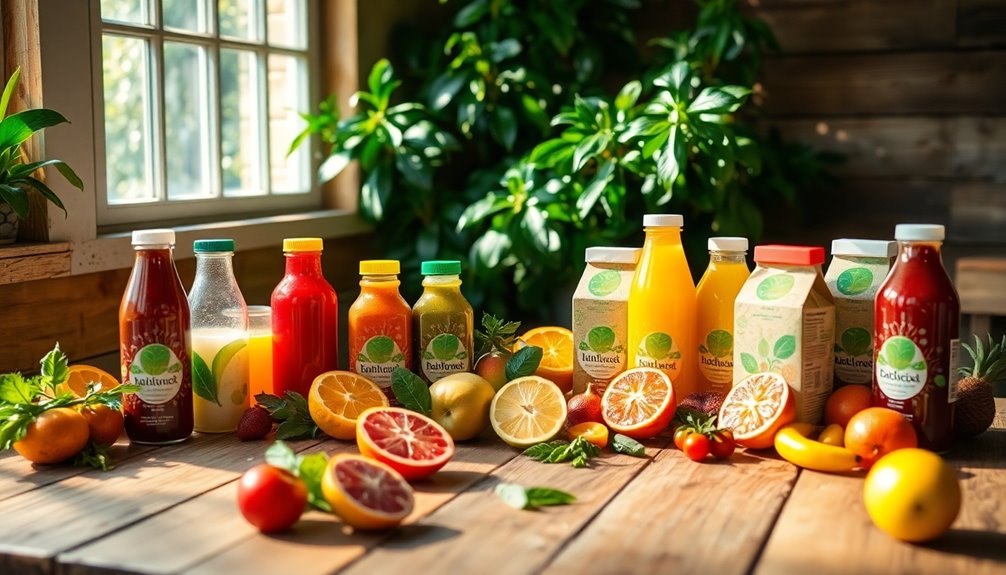
While the demand for sustainable juice packaging continues to rise, brands are actively exploring innovative solutions that align with eco-conscious consumer values.
Expect to see advancements like recyclable films and mono-material pouches, which considerably cut environmental impact without sacrificing product integrity.
Innovations in sustainable packaging, such as bio-based and compostable materials made from corn starch and sugarcane, are gaining traction for their quick decomposition.
Aseptic technology is also set to expand, allowing longer shelf life without refrigeration, which helps lower energy consumption.
Additionally, smart packaging integrated with IoT technology may enhance convenience by enabling automatic reordering and real-time freshness monitoring.
Ultimately, brands are prioritizing eco-friendly designs that maintain juice quality while meeting consumer sustainability demands.
Frequently Asked Questions
How Can I Identify Truly Sustainable Juice Packaging?
To identify truly sustainable juice packaging, start by checking the materials used.
Look for packaging made from recycled, biodegradable, or plant-based materials. Research the brand's commitment to sustainability; they should provide transparency about their sourcing and production processes.
Certifications like FSC (Forest Stewardship Council) or compostable logos can be good indicators.
Also, consider the packaging's lifecycle—does it minimize waste and promote recycling?
Your choices can drive demand for better practices in the industry.
What Are the Costs Associated With Sustainable Packaging Solutions?
Think of sustainable packaging as a garden; it requires investment to grow. The costs associated with these solutions can vary widely, depending on materials and production methods.
While initial expenses might be higher than traditional options, consider long-term savings from reduced waste and potential consumer loyalty.
You've got to balance short-term costs against the environmental benefits and market trends.
In the end, sustainability can yield a fruitful return on investment.
Are There Certifications for Eco-Friendly Juice Packaging?
Yes, there are several certifications for eco-friendly juice packaging that you can look for.
These include FSC (Forest Stewardship Council) certification for responsibly sourced paper, and the Cradle to Cradle certification, which evaluates product safety and environmental performance.
You might also encounter certifications like Biodegradable Products Institute (BPI) that guarantee compostability.
When choosing packaging, these certifications can help you confirm that you're making a sustainable choice for your juice products.
How Can I Recycle or Dispose of Juice Containers Responsibly?
Recycling juice containers is like giving them a second life, ensuring they don't end up in a landfill.
First, rinse out the containers to remove residue.
Check your local recycling guidelines, as some plastics are accepted while others aren't.
If recycling's not an option, consider repurposing them for storage or crafts.
Finally, always dispose of any non-recyclable waste in your regular trash to keep your environment clean and safe.
What Is the Shelf Life of Biodegradable Juice Packaging?
The shelf life of biodegradable juice packaging typically ranges from a few weeks to several months, depending on the materials used and environmental conditions.
You should always check the manufacturer's guidelines for specific products.
While these packages break down more quickly than traditional plastics, they may still require proper storage to maintain freshness.
If you're concerned about waste, consider using them before their expiration for ideal taste and to minimize your environmental impact.
Conclusion
As you explore these sustainable solutions for juice packaging and storage, it's clear that the future looks bright for eco-friendly choices. By embracing innovations like biodegradable materials and reusable containers, you're not just quenching your thirst; you're also doing your part for the planet. With consumer preferences driving change, it's time to jump on the bandwagon and support a greener way to enjoy your favorite juices. Together, we can make a world of difference!
Cindy thoroughly researches juicing trends, techniques, and recipes to provide readers with practical advice and inspiration. Her writing style is accessible, engaging, and designed to make complex concepts easy to understand. Cindy’s dedication to promoting the advantages of juicing shines through her work, empowering readers to make positive changes in their lives through the simple act of juicing.

